China Brands, Marketing & Consumers
The Legendary Lao Gan Ma: How Chili Sauce Billionaire Tao Huabi Became a ‘Chinese Dream’ Role Model
The story of Lao Gan Ma founder Tao Huabi.
Published
4 years agoon
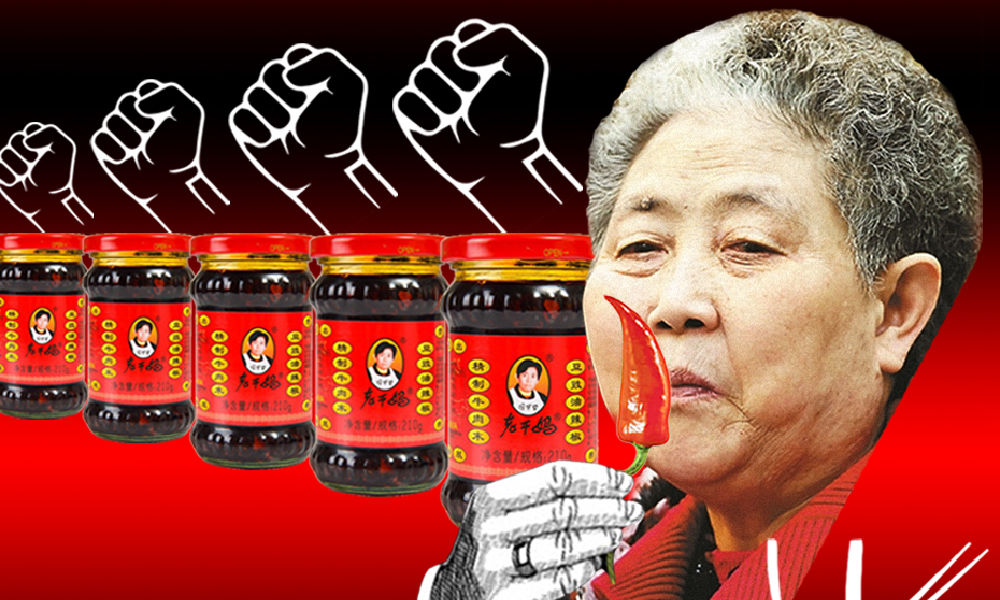
PREMIUM CONTENT
You might know the chili sauce Lao Gan Ma, a household name in China. But perhaps you’re less familiar with the story behind the sauce and its founder, which has inspired millions of people and has made ‘Old Godmother’ Tao Huabi a notable figure in Chinese contemporary culture today. For many, the successful businesswoman and ‘chili sauce queen’ is an embodiment of the ‘Chinese dream.’
This is the “WE…WEI…WHAT?” column by Manya Koetse, original publication in German by Goethe Institut China (forthcoming), visit Yi Magazin: WE…WEI…WHAT? Manya Koetse erklärt das chinesische Internet.
Lao Gan Ma t-shirts, Lao Gan Ma phone covers, Lao Gan Ma bracelets, and even Lao Gan Ma airpod cases – Lao Gan Ma is more fashionable than ever in China today.
The celebrated brand is one of the country’s most well-known chili sauce labels, and it pops up in Chinese media and online culture every single day; not just because of its tasty condiments and other food products, but also because of the company’s remarkable history and evolution.
Besides the popularity of Lao Gan Ma’s crispy chili oil, it is the story of founder Tao Huabi (陶华碧) that plays a crucial role in the brand’s contemporary success. It is her face you see on the recognizable packaging design that has become a household product and is now also famous in many countries outside of China.
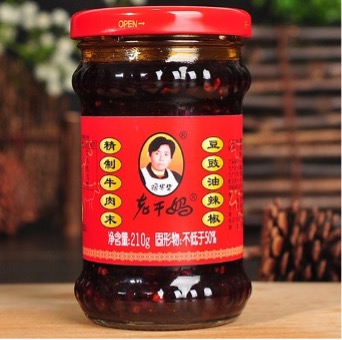
The iconic Lao Gan Ma, image via www.szmtzc.com
The brand name ‘Lao Gan Ma’ (老干妈) literally means ‘Old Godmother’ and refers to Tao Huabi herself. She is the creator of the famous chili sauces who has, over time, become the embodiment of the ‘Chinese dream.’ By following her own path and relying on her business instinct, Tao rose from poverty and became one of China’s richest women.
In order to explain why Tao Huabi is such an iconic figure in China today, let’s look at this famous female entrepreneur by highlighting the different stages of her Lao Gan Ma journey.
1: The Young Tao Huabi: “If I Hadn’t Been Strong, I Would’ve Starved”
“There are many successful businesses entrepreneurs who have experienced hardships, but there are few whose starting point was as low as Tao’s.” These are the opening lines of a popular book about Tao Huabi, written by Zhang Lina (张丽娜), telling the story of her life.1
Tao Huabi was born in 1947 in a small village in Meitan County, Guizhou, one of China’s poorest provinces. She was the eighth daughter in her family (her parents had actually hoped to finally have a son), and her parents struggled to feed and clothe their children, let alone give them proper education. Tao was not taught how to read and write.
The biography about Tao Huabi describes how Tao spent her younger years chopping wood, cooking and farming. The title of the book is If I Hadn’t Been Strong, I Would’ve Starved (我不坚强,就没得饭吃), and it is telling of how Tao’s younger years were all about being hungry and finding ways to keep on going.
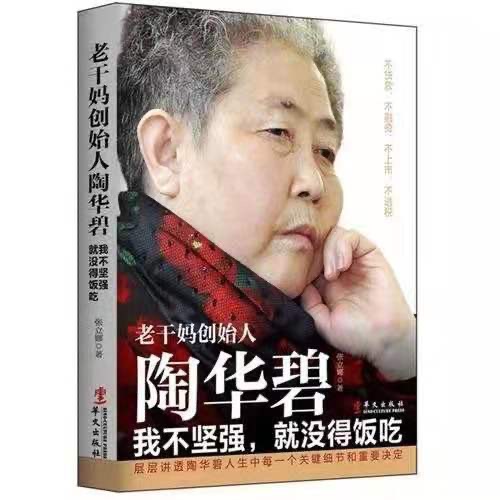
Tao Huabi’s biography, written by Zhang Nali. Image via Shanghuibs.
During the Great Chinese Famine (1959-1961), Tao dug for wild vegetables and tried various ways to eat plant roots, using whatever she had to try and make the little food they had taste better. This is how poverty and hunger drove the young Tao to make her very first chili sauce. The natural sauce, made from medicinal plants from the mountains and home-grown chili peppers, was loved by the entire family.
When Tao was 20 years old, she married her husband, who worked as an accountant with the local geological team. They had two sons together. But the happy life of the young family did not last long as just a few years into their marriage, Tao’s husband became seriously ill with liver disease.
Tao now found herself in an incredibly difficult situation; she was uneducated, illiterate, and had no official working experience. But she needed to provide income for her family as they had no money to cover her husband’s medical costs and pay for the food and education of their two sons. The 30-yuan monthly income of her husband was nowhere near enough to help the family.
The situation led Tao to head out of the countryside for the first time in her life to go to the city of Guangzhou to find a factory job as a migrant worker. She brought her own homemade chili sauce with her to the faraway city and used it to flavor her steamed buns when she couldn’t afford any other food. She also shared it with her co-workers, who found her chili sauce to be delicious.
Unfortunately, Tao’s efforts could not save her husband’s life. She soon became widowed and, heartbroken, had to return back to Guizhou to take care of her two young boys. Now that she had become the sole caregiver and provider of her family, she started selling rice curd and also set up a street stall selling vegetables at all hours of the day, often working until 4 in the morning.
Her passion for cooking kept following Tao wherever she went. One day, when Tao’s sons were already grown up, she visited a noodle shop after work and complained to the female shop owner that their cold noodles were not authentic enough. After Tao gave the lady her tips and tricks on how to improve the noodles using chili oil, she was offered a job at the noodle stall. The experience at the shop eventually gave Tao the idea to start her own business.
2: Inspirational Business Journey: “Selling the Flavor”
In 1989, when Tao was 42, she set up her own little “Economical Restaurant” (“实惠饭店”) in the Nanming District of Guiyang, Guizhou. Although she just served simple noodles, she mixed them with her own spicy hot sauce with soybeans. Tao was beloved in the neighborhood, where she became a ‘godmother’ to poor students whom she would always give discounts and some extra food.
With many local students and patrons visiting her little diner, the noodle shop business soon flourished, but not because of her noodles – it was the chili sauce that kept people coming back for more.
Tao Huabi came to understand the popularity of her condiments when customers came in to purchase the sauce by itself, without the noodles. One day, when her sauce had sold out, she found that customers would not even eat her noodles without the chili. When Tao learned that other noodle shops in the neighborhood were all doing good business by using her home-made sauce in their noodles, she finally realized the true potential of her product.
By the early 1990s, more truck drivers passed by Tao’s shop due to the construction of a new highway in the area. Tao took this as a chance to promote her condiments outside the realm of her own neighborhood and started giving out her sauces for free for the truckers to take home. This form of word-of-mouth marketing soon paid off when people from outside the city district came to visit Tao’s shop to buy her chili sauces and other condiments.
By late 1994, Tao had stopped selling noodles and had turned her little restaurant into a specialty store called ‘Tao’s Guiyang Nanming Food Shop’ (“贵阳南明陶氏风味食品店”), with the chili oil sauce being the number one product.
Two years later, at the age of 49, Tao took the plunge to rent a house in Guiyang, recruited forty workers, and set up her own sauce factory called ‘Old Godmother’: ‘Lao Gan Ma‘ (老干妈). Since the factory initially had no machines, the chili chopping was all done manually. Tao herself, wearing her apron, would also cut chilis at the factory tables together with her workers.
In 1997, the company was officially listed and open for business. Although Tao never had any formal education, she turned out to have a natural talent for managing her flourishing company. Tao’s two sons later also joined the Lao Gan Ma company.
Although the Lao Gan Ma brand became successful almost immediately after its launch, Tao Huabi still struggled for years as a handful of competitors launched fake Lao Gan Ma sauces with similar packaging, and nearly ruined her business. In 2001, when Tao Huabi was 54, the high court in Beijing finally ruled that other similar products could not use the “Lao Gan Ma” name nor imitate her packages. She received 400,000 RMB in compensation ($60,000).
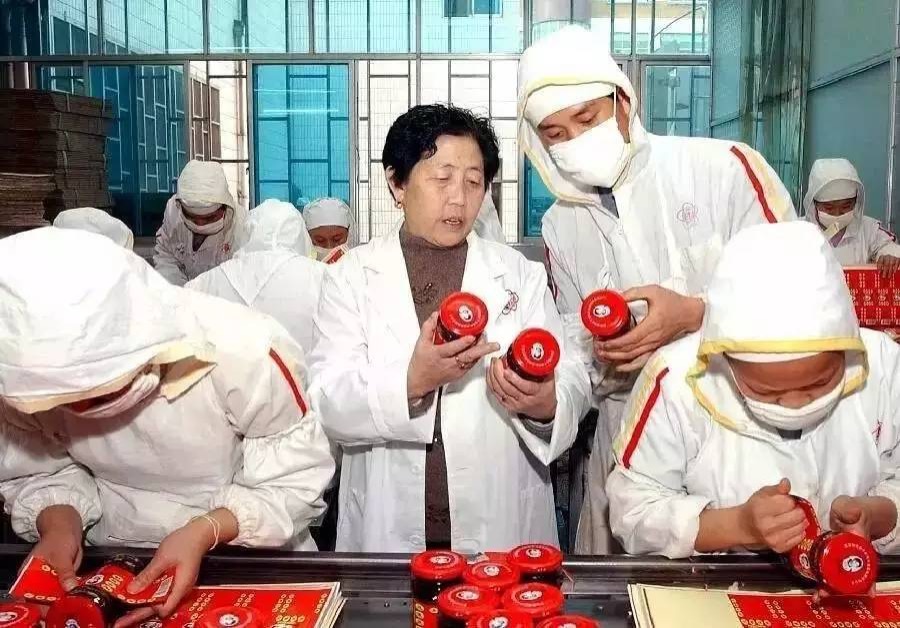
Tao Huabi in her factory, image via Sohu.com.
Lao Gan Ma eventually employed over 2000 factory workers and became the largest producer and seller of chili products in China, reaching a point where the company produced 1.3 million bottles of chili sauce every day. Besides the iconic Fried Chili in Oil and Chili Crisp Sauce, Lao Gan Ma also produces Black Beans Chili Sauce, Tomato Chili Sauce, hot pot soup base, and other condiments.
By now, Tao’s ‘chili empire’ has gone international, as her condiments are sold from the USA to Africa. Tao Huabi once famously said that she does not know all the countries outside of China where Lao Gan Ma is sold, but that she does know that Lao Gan Ma is sold wherever there are Chinese people.
In 2019, Lao Gan Ma was selected as one of the top 100 brands in China, together with other famous national brands such as China Mobile, Huawei, Tik Tok, Tsingtao, and Alibaba.
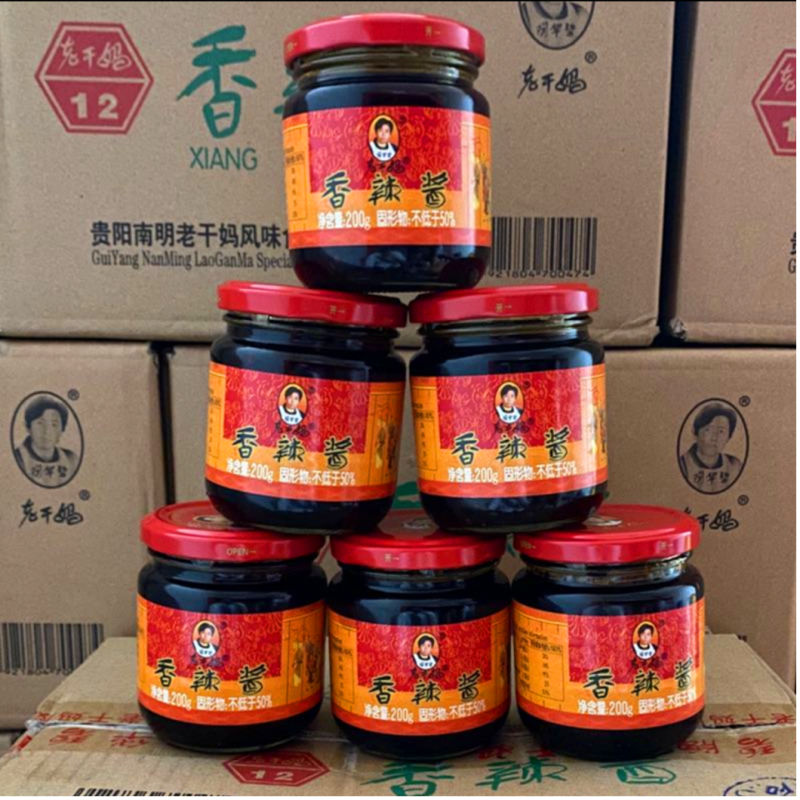
Lao Gan Ma packaging, image via Taobao.
What is striking about the Lao Gan Ma business model is that it does not follow the usual marketing strategy tactics. The company rarely advertises, there are no celebrity endorsements, no social media accounts or campaigns, the website hasn’t been updated for years, and the Lao Gan Ma packaging has never modernized: it’s been the same old-fashioned logo for decades.
It is a marketing strategy that follows Tao’s no-nonsense line of thinking: if your product is good enough, people will buy it again. “We’re selling the flavor, not the packaging,” Tao herself once said.
3: The Old Godmother: “Labor Builds the Chinese Dream”
In the eyes of many, Tao Huabi is an embodiment of the ‘Chinese dream.’ A few years ago, Chinese state broadcaster CCTV produced a TV series titled “Labor Builds the Chinese Dream” (劳动铸就中国梦), and one of its episodes featured Tao Huabi, who is now 74 years old.
The main narrative of the documentary is that all people built on a country’s wealth together with each other as a collective goal – not an individual one. The idea of the ‘China Dream’ has been especially ubiquitous in Chinese official media since Xi Jinping became president in 2013. The concept refers to “the great rejuvenation of the Chinese nation.” In his first address to the nation in March of 2013, Xi emphasized that in order to realise the “Chinese road”: “(..) we must spread the Chinese spirit, which combines the spirit of the nation with patriotism as the core and the spirit of the time with reform and innovation as the core.”
Tao’s story fits this idea of the Chinese shared ‘road to prosperity’ dream. She started out poor but created her own business in spite of all obstacles. Along the way, she was always prepared to help out others while she herself rarely relied on her network or other people’s money to reach her goals.
Throughout her business journey, Tao has stayed true to her province, earning her the “Miracle of Guizhou” nickname. Despite the many offers she had throughout her career to set up her business elsewhere, she always refused to leave her home base – much to the delight of local government officials who have continuously shown their support for Tao. The businesswoman is a blessing for the province; not just because her brand has become known as a unique ‘product of Guizhou’, but mainly because she offers employment to nearly 5000 staff members, and directly and indirectly generates income for ten-thousands of local farmers.
Tao is also a Party member, and she is politically active as, among others, a representative of the Standing Committee of the Guizhou Provincial People’s Congress. She attended the National People’s Congress in Beijing multiple times.
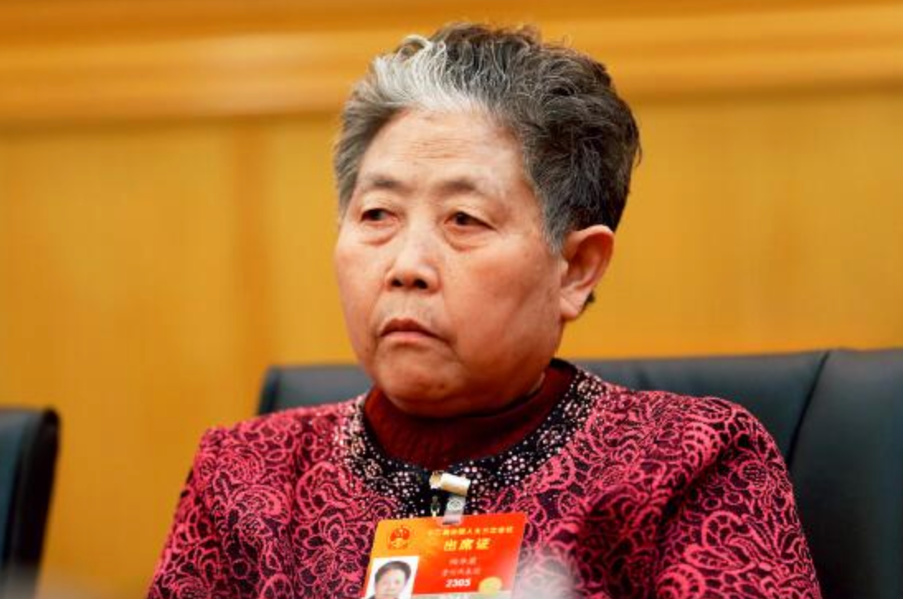
Tao Huabi at the Two Sessions, photo via Sohu.com.
While Lao Gan Ma is one of China’s national brands, Tao Huabi is often also seen as a patriotic entrepreneur. Lao Gan Ma’s condiments are much more expensive outside in foreign countries than in China. While a two-pack of Lao Gan Ma is sold for only 9.9 yuan ($1.5) on Chinese e-commerce platform Taobao, the same pack is sold in the US for 13 up to 18 dollars on the American Amazon: eight to twelve times more expensive than the Chinese price. When asked about the enormous Lao Gan Ma price difference between China and other countries, Tao said: “I’m Chinese. I don’t make money off of Chinese people. I want to sell Lao Gan Ma to foreign countries and make money off of foreigners.”
Lao Gan Ma’s popularity outside of China has risen over the past decade. On Facebook, there is even a public group called “The Lao Gan Ma (老干妈) Appreciation Society,” where the group members (over 4000!) share their love for the brand.
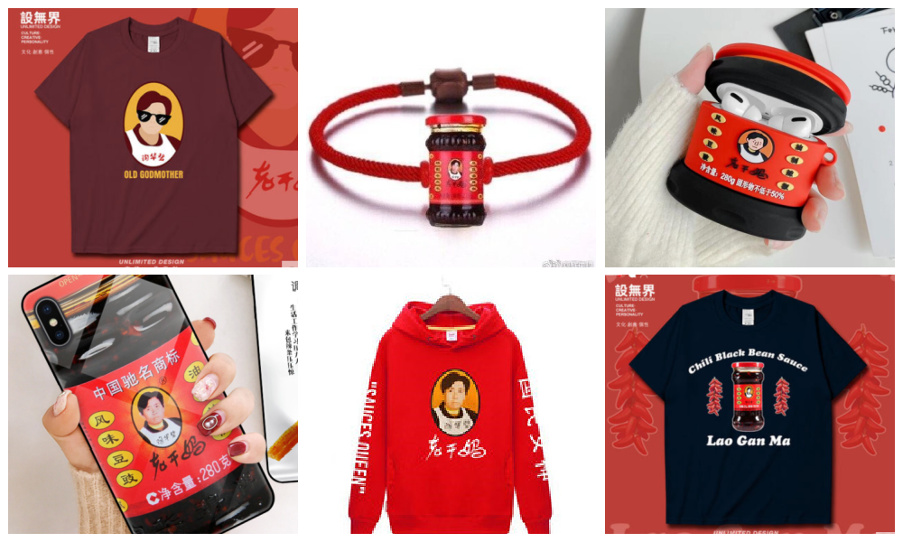
Examples of Tao Huabi featured in fashion and accessories. Tao Huabi as a fashion icon?!
Meanwhile, on Chinese social media platform Weibo, Lao Gan Ma and Tao Huabi’s story often pop up in people’s posts: “Old Godmother is an example that you can still make it in life without any education.”
Perhaps there is no better person to embody the Chinese dream than Tao Huabi, who has experienced life in China from so many different angles. A poor farmer’s daughter, a young struggling widow, a migrant factory worker, a loving mother, a roadside peddler, a business manager, a loyal Party member, and even an unexpected fashion icon – Tao Huabi has seen and been it all. There is one thing she will always be: China’s chili sauce queen.
By Manya Koetse
Follow @whatsonweibo
1 Zhang Nali 张丽娜. 2019 (2016). Tao Huabi, Founder of Lao Gan Ma: If I Wouldn’t Have Been Strong, I Would’ve Starved [老干妈创始人陶华碧 我不坚强就没得饭吃] (in Chinese). Beijing: Chinese Publishing House. ISBN 978-7-5075-4451-0.
Featured image by Ama for Yi Magazin.
This text was written for Goethe-Institut China under a CC-BY-NC-ND-4.0-DE license (Creative Commons) as part of a monthly column in collaboration with What’s On Weibo.
Spotted a mistake or want to add something? Please let us know in comments below or email us. First-time commenters, please be patient – we will have to manually approve your comment before it appears.
Manya is the founder and editor-in-chief of What's on Weibo, offering independent analysis of social trends, online media, and digital culture in China for over a decade. Subscribe to gain access to content, including the Weibo Watch newsletter, which provides deeper insights into the China trends that matter. More about Manya at manyakoetse.com or follow on X.

China Brands, Marketing & Consumers
Signals: Hasan Piker’s China Trip & the Unexpected Journey of a Chinese School Uniform to Angola
Hasan Piker’s controversial China tour, a Chinese school uniform resurfaces in Africa, a new winter hotspot, why Chinese elites ‘run’ to Tokyo, and more.
Published
1 week agoon
November 21, 2025
🌊 Signals — Week 47 (2025)
Part of Eye on Digital China, Signals highlights slower trends and online currents behind the daily scroll. This edition was sent to paid subscribers — subscribe to receive the next issue in your inbox.
Welcome to another edition of Eye on Digital China. Different from the China Trend Watch (check the latest one here if you missed it), this edition, part of the new Signals series, is about the slower side of China’s social media: the recurring themes and underlying shifts that signal broader trends beyond the quick daily headlines. Together with the deeper dives, the three combined aim to give you clear updates and a fuller overview of what’s happening in China’s online conversations & digital spaces.
For the coming two weeks, I’ll be traveling from Beijing to Chongqing and beyond (more on that soon) so please bear with me if my posting frequency dips a little. I’ll be sure to pick it up again soon and will do my best to keep you updated along the way. In the meantime, if you know of a must-try hotpot in Chongqing, please do let me know.
In this newsletter: Hasan Piker’s controversial China tour, a Chinese school uniform in Angola, a new winter hotspot, discussions on what happens to your Wechat after you die, why Chinese elites rùn to Tokyo, and more. Let’s dive in.
- 💰 The richest woman in China, according to the latest list by Hurun Research Institute, is the “queen of pharmaceuticals” Zhong Huijuan (钟慧娟) who has accumulated 141 billion yuan (over 19 billion USD). Women account for over 22% of Chinese billionaires (those with more than 5 billion RMB), underscoring China’s globally leading position in producing wealthy female entrepreneurs.
- 🧩 What happens to your WeChat after you die? A user who registered for NetEase Music with a newly reassigned phone number unexpectedly gained access to the late singer Coco Lee’s (李玟) account, as the number had originally belonged to her. The incident has reignited debate over how digital accounts should be handled after death, prompting platforms like NetEase and Tencent to reconsider policies on long-inactive accounts and take stronger measures to protect them.
- 📱 Although millions of viewers swoon over micro-dramas with fantasy storylines where rich, powerful men win over the “girl next door” through money and status, Chinese regulators are now stepping in to curb exaggerated plots featuring the so-called “dominant CEO” (霸道总裁) archetype, signaling stricter oversight for the booming short drama market.
- ☕ A popular Beijing coffee chain calling itself “People’s Cafe” (人民咖啡馆), with its style and logo evoking nationalist visual nostalgia, has changed its name after facing criticism for building its brand – including pricey coffee and merchandise – on Mao era and state-media political connotations. The cafe is now ‘Yachao People’s Cafe’ (要潮人民咖啡馆).
- 👀 Parents were recently shocked to see erotic ads appear on the Chinese nursery rhymes and children’s learning app BabyBus (宝宝巴士), which is meant for kids ages 0–8. BabyBus has since apologized, but the incident has sparked discussions about how to keep children safe from such content.
- 🧧The 2026 holiday schedule has continued to be a big topic of conversation as it includes a 9-day long Spring Festival break (from February 15 to February 23), making it the longest Lunar New Year holiday on record. The move not only gives people more time for family reunions, but also gives a huge boost to the domestic travel industry.
Hasan Piker’s Chinese Tour & The US–China Content Honeymoon
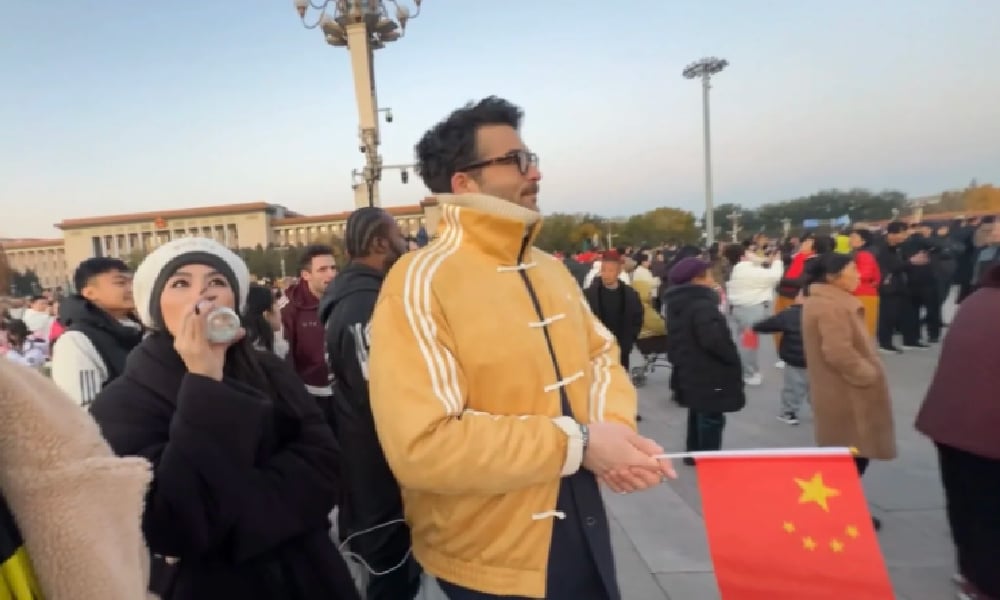
Livestreamer Hasan Piker during his visit to Tiananmen Square flag-rising ceremony.
It’s not time for the end-of-year overviews just yet – but I’ll already say that 2025 was the US–China ‘honeymoon’ year for content creation. It’s when China became “cool,” appealing, and eye-grabbing for young Western social media users, particularly Americans. The recent China trip of the prominent American online streamer Hasan Piker fits into that context.
This left-wing political commentator also known as ‘HasanAbi’ (3 million followers on Twitch, recently profiled by the New York Times) arrived in China for a two-week trip on November 11.

Piker screenshot from the interview with CGTN, published on CGTN.
His visit has been controversial on English-language social media, especially because Piker, known for his criticism of America (which he calls imperialist), has been overly praising China: calling himself “full Chinese,” waving the Chinese flag, joining state media outlet CGTN for an interview on China and the US, and gloating over a first-edition copy of Quotations from Chairman Mao (the Little Red Book). He portrays China as heavily misrepresented in the West and as a country the United States should learn from.
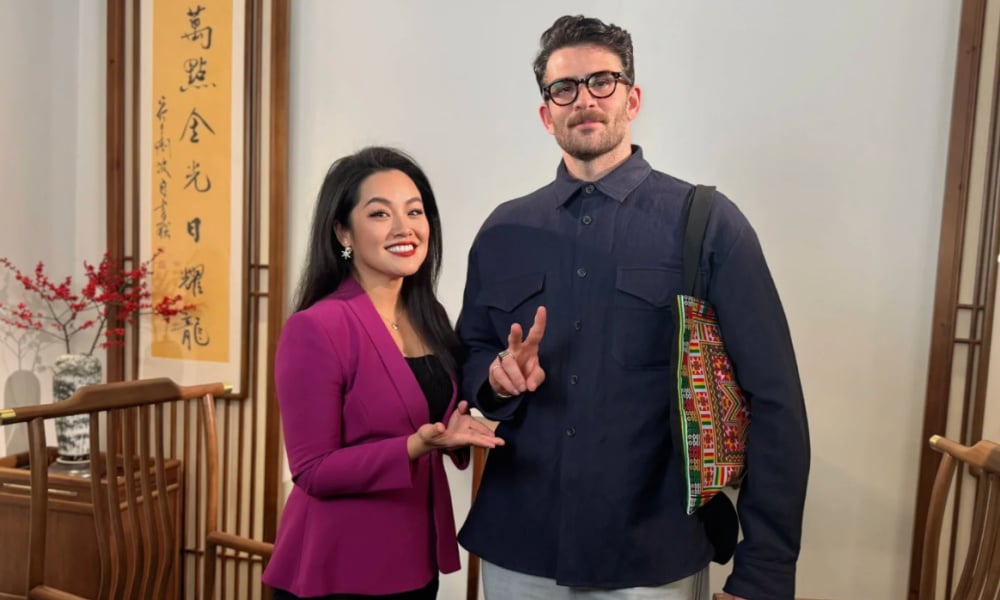
Hasan Piker did an interview with CGTN, posing with Li Jingjing 李菁菁.
During his livestreaming tour, Hasan, who is nicknamed “lemonbro” (柠檬哥) by Chinese netizens, also joined Chinese platforms Bilibili and Xiaohongshu.
But despite all the talk about Piker in the American online media sphere, online conversations, clicks, and views within China are underwhelming. As of now, he has around 24,000 followers on Bilibili, and he’s barely a topic of conversation on mainstream feeds.
Piker’s visit stands in stark contrast to that of American YouTuber IShowSpeed (Darren Watkins), who toured China in March. With lengthy livestreams from Beijing to Chongqing, his popularity exploded in China, where he came to be seen by many as a representative of cultural diplomacy.

IShowspeed in China, March 2025.
IShowSpeed’s success followed another peak moment in online US–China cultural exchange. In January 2025, waves of foreign TikTok users and popular creators migrated to the Chinese lifestyle app Xiaohongshu amid the looming TikTok ban.
Initially, the mass migration of American users to Xiaohongshu was a symbolic protest against Trump and US policies. In a playful act of political defiance, they downloaded Xiaohongshu to show they weren’t scared of government warnings about Chinese data collection. (For clarity: while TikTok is a made-in-China app, it is not accessible inside mainland China, where Douyin is the domestic version run by the same parent company).
The influx of foreigners — who were quickly nicknamed “TikTok refugees” — soon turned into a moment of cultural celebration. As American creators introduced themselves, Chinese users welcomed them warmly, eager to practice English and teach newcomers how to navigate the app. Discussions about language, culture, and societal differences flourished. Before long, “TikTok refugees” and “Xiaohongshu natives” were collaborating on homework assignments, swapping recipes, and bonding through humor. It was a rare moment of social media doing what we hope it can do: connect people, build bridges, and replace prejudice with curiosity.
Some of that same enthusiasm was also visible during IShowSpeed’s China tour. Despite the tour inevitably getting entangled with political and commercial interests, much of it was simply about an American boy swept up in the high energy of China’s vibrant cities and everything they offer.
Different from IShowSpeed, who is known for his meme-worthy online presence, Piker is primarily known for his radical political views. His China enthusiasm feels driven less by cultural curiosity and more by his critique of America.
Because of his stances — such as describing the US as a police state — it’s easy for Western critics to accuse him of hypocrisy in praising China, especially after a brief run-in with security police while livestreaming at Tiananmen Square.
Seen in broader context, Piker’s China trip reflects a shift in how China is used in American online discourse.
Before, it was Chinese ‘public intellectuals’ (公知) who praised the US as a ‘lighthouse country’ (灯塔国), a beacon of democracy, to indirectly critique China and promote a Western modernization model. Later, Chinese online influencers showcased their lives abroad to emphasize how much ‘brighter the moon’ was outside China.
In the post-Covid years, the current reversed: Western content creators, from TikTok influencers to political commentators, increasingly use China to make arguments that are fundamentally about America.
Between these cycles, authentic cultural curiosity gets pushed to the sidelines. The TikTok-refugee moment in early January may have been the closest we’ve come in years: a brief window where Chinese and American users met each other with curiosity, camaraderie, and creativity.
Hasan’s tour, in contrast, reflects a newer phase, one where China is increasingly used as a stage for Western political identity rather than a complex and diverse country to understand on its own terms. I think the honeymoon phase is over.
“Liu Sihan, Your School Uniform Ended Up in Angola”: China’s Second-Hand Clothing in Africa
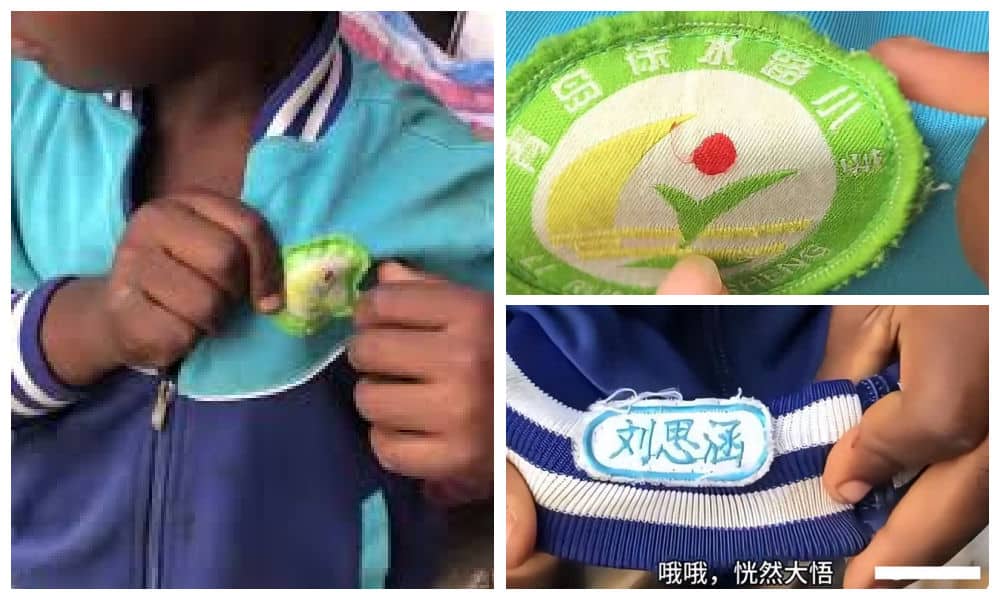
A Chinese school uniform went viral after a Chinese social media user spotted it in Angola.
“Liu Sihan, your schooluniform is hot in Africa” (刘思涵你的校服在非洲火了) is a sentence that unexpectedly trended after a Chinese blogger named Xiao Le (小乐) shared a video of a schoolkid in Angola wearing a Chinese second-hand uniform from Qingdao Xushuilu Primary School, that had the nametag Liu Sihan on it.
The topic sparked discussions about what actually happens to clothing after it’s donated, and many people were surprised to learn how widely Chinese discarded clothing circulates in parts of Africa.
Liu Sihan’s mother, whose daughter is now a 9th grader in Qingdao, had previously donated the uniform to a community clothing donation box (社区旧衣回收箱) after Liu outgrew it. She intended it to help someone in need, never imagining it to travel all the way to Africa.
In light of this story, one netizen shared a video showing a local African market selling all kinds of Chinese school items, including backpacks, and people wearing clothing once belonging to workers for Chinese delivery platforms. “In Africa, you can see school uniforms from all parts of China, and even Meituan and Eleme outfits,” one blogger wrote.
When it comes to second-hand clothing trade, we know much more about Europe–Africa and US–Africa flows than about Chinese exports, and it seems there haven’t been many studies on this specific topic yet. Still, alongside China’s rapid economic transformations, the rise of fast fashion, and the fact that China is the world’s largest producer and consumer of textiles, the country now has an enormous abundance of second-hand clothing.
According to a 2023 study by Wu et al. (link), China still has a long way to go in sustainable clothing disposal. Around 40% of Chinese consumers either keep unwanted clothes at home or throw them away.
But there may be a shift underway. Donation options are expanding quickly, from government bins to brand programs, and from second-hand stores to online platforms that offer at-home pickup.

Chinese social media users posting images of school/work uniforms from China worn by Africans.
As awareness grows around the benefits of donating clothing (reducing waste, supporting sustainability, and the emotional satisfaction of giving), donation rates may rise significantly. The story of Liu Sihan’s uniform, which many found amusing, might even encourage more people to donate. And if that happens, scenes of African children (and adults) wearing Chinese-donated clothes may become much more common than they now are.
Laojunshan: New Hotspot in Cold Winter

Images from Xiaohongshu, 背包里的星子, 旅行定制师小漾
Go to Zibo for BBQ, go to Tianshui for malatang, go to Harbin for the Ice Festival, cycle to Kaifeng for soup dumplings, or head to Dunhuang to ride a camel — over recent years, a number of Chinese domestic destinations have turned into viral hotspots, boosted by online marketing initiatives and Xiaohongshu influencers.
This year, Laojunshan is among the places climbing the trending lists as a must-visit spot for its spectacular snow-covered landscapes that remind many of classical Chinese paintings. Laojunshan (老君山), a scenic mountain in Henan Province, is attracting more domestic tourists for winter excursions.
Xiaohongshu is filled with travel tips: how to get there from Luoyang station (by bus), and the best times of day to catch the snow in perfect light (7–9 AM or around 6–6:30 PM).
With Laojunshan, we see a familiar pattern: local tourism bureaus, state media, and influencers collectively driving new waves of visitors to the area, bringing crucial revenue to local industries during what would otherwise be slower winter months.
WeChat New Features & Hong Kong Police on Douyin
🟦 WeChat has been gradually rolling out a new feature that allows users to recall a batch of messages all at once, which saves you the frantic effort of deleting each message individually after realizing you sent them to the wrong group (or just regret a late-night rant). Many users are welcoming the update, along with another feature that lets you delete a contact without wiping the entire chat history. This is useful for anyone who wants to preserve evidence of what happened before cutting ties.
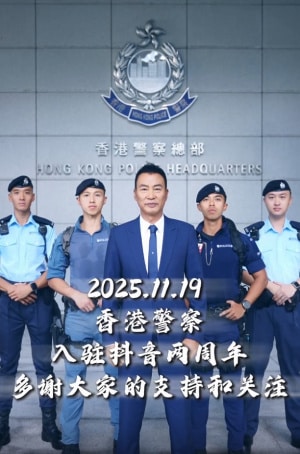
🟦The Hong Kong Police Force recently celebrated its two-year anniversary on Douyin (the Chinese version of TikTok), having accumulated nearly 5 million followers during that time. To mark the occasion, they invited actor Simon Yam to record a commemorative video for their channel (@香港警察). The presence of the Hong Kong Police on the Chinese app — and the approachable, meme-friendly way they’ve chosen to engage with younger mainland audiences — is yet another signal of Hong Kong institutions’ strategic alignment with mainland China’s digital infrastructure, a shift that has been gradually taking place. The anniversary video proved popular on Douyin, attracting thousands of likes and comments.
Why Chinese Elite Rùn to Japan (by ChinaTalk)
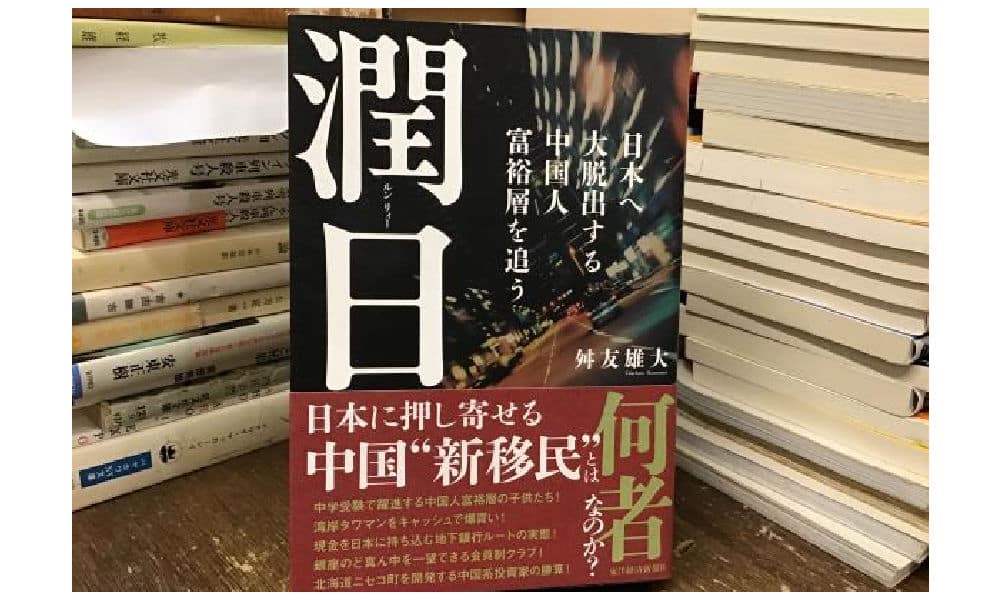
Over the past week, Japan has been trending every single day on Chinese social media in light of escalating bilateral tensions after Japanese PM Takaichi made remarks about Taiwan that China views as a direct military threat. The diplomatic freeze is triggering all kinds of trends, from rising anti-Japanese sentiment online and a ban on Japanese seafood imports to Chinese authorities warning citizens not to travel to Japan.
You’d think Chinese people would want to be anywhere but Japan right now — but the reality is far more nuanced.
In a recent feature in ChinaTalk, Jordan Schneider interviewed Japanese journalist & researcher Takehiro Masutomo (舛友雄大) who has just published a book about Japan’s new Chinese diaspora, explaining what draws Chinese dissidents, intellectuals, billionaires, and middle-class families to Tokyo.
The book is titled Run Ri: 潤日 Following the Footsteps of Elite Chinese Escaping to Japan (only available in Japanese and Traditional Chinese for now). (The word Rùn 润/潤, by the way, is Chinese online slang and meme expresses the desire to escape the country.)
A very interesting read on how Chinese communities are settling in Japan, a place they see as freer than Hong Kong and safer than the U.S., and one they’re surprisingly optimistic about — even more so than the Japanese themselves.
Thanks for reading this Eye on Digital China Signals. For fast-moving trends and deeper dives, keep an eye on the upcoming newsletters.
And if you just so happen to be reading this without a subscription and appreciate my work, consider joining to receive future issues straight in your inbox.
A small housekeeping note:
This Eye on Digital China newsletter is co-published for subscribers on both Substack and the main site. If you’re registered on both platforms, you’ll receive duplicate emails — so if that bothers you, please pick your preferred platform and unsubscribe from the other.
Many thanks to Miranda Barnes for helping curate some of the topics in this edition.
— Manya
Spotted an error or want to add something? Comment below or email me.
First-time commenters require manual approval.
©2025 Eye on Digital China / What’s on Weibo. Do not reproduce without permission —
contact info@whatsonweibo.com.
China Brands, Marketing & Consumers
House of Wahaha: Zong Fuli Resigns
In the year following her father’s death, Zong Fuli dealt with controversy after controversy as the head of Chinese food & beverage giant Wahaha.
Published
2 months agoon
October 14, 2025
It’s a bit like a Succession-style corporate drama 🍿.
Over the past few years, we’ve covered stories surrounding Chinese beverage giant Wahaha (娃哈哈) several times — and with good reason.
Since the passing of its much-beloved founder Zong Qinghou (宗庆后) in March 2024, the company has been caught in waves of internal turmoil.
Some context: Wahaha is regarded as a patriotic brand in China — not only because it’s the country’s equivalent of Coca-Cola or PepsiCo (they even launched their own cola in 1998 called “Future Cola” 非常可乐, with the slogan “The future will be better” 未来会更好), but also because its iconic drinks are tied to the childhood memories of millions.
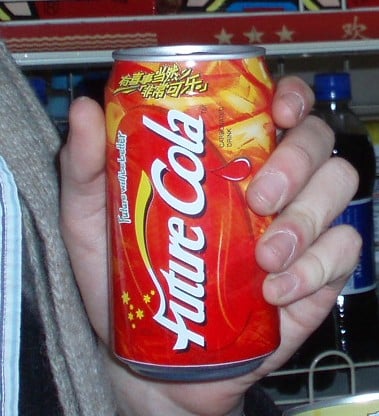
Future Cola by Wahaha via Wikipedia.
There’s also the famous 2006 story when Zong Qinghou refused a buyout offer from Danone. Although the details of that deal are complex, the rejection was widely seen as Zong’s defense of a Chinese brand against foreign takeover, contributing to his status as a national business hero.
After the death of Zong, his daughter Zong Fuli, also known as Kelly Zong (宗馥莉), took over.
🔹 But Zong Fuli soon faced controversy after controversy, including revelations that Wahaha had outsourced production of some bottled water lines to cheaper contractors (link).
🔹 There was also a high-profile family inheritance dispute involving three illegitimate children of Zong Qinghou, now living in the US, who sued Zong Fuli in Hong Kong courts, claiming they were each entitled to multi-million-dollar trust funds and assets.
🔹 More legal trouble arrived when regulators and other shareholders objected to Zong Fuli using the “Wahaha” mark through subsidiaries and for new products outside officially approved channels (the company has 46% state ownership).
⚡️ The trending news of the moment is that Zong Fuli has officially resigned from all positions at Wahaha Group as chairman, legal representative, and director. She reportedly resigned on September 12, after which she started her own brand named “Wa Xiao Zong” (娃小宗). One related hashtag received over 320 million views on Weibo (#宗馥莉已经辞职#). Wahaha’s board confirmed the move on October 10, appointing Xu Simin (许思敏) as the new General Manager. Zong remains Wahaha’s second-largest shareholder.
🔹 To complicate matters further, Zong’s uncle, Zong Wei (宗伟), has now launched a rival brand — Hu Xiao Wa (沪小娃) — with product lines and distribution networks nearly identical to Wahaha’s.
As explained by Weibo blogger Tusiji (兔撕鸡大老爷), under Zong Qinghou, Wahaha relied on a family-run “feudal” system with various family-controlled factories. Zong Fuli allegedly tried to dismantle this system to centralize power, fracturing the Wahaha brand and angering both relatives and state investors.
Others also claim that Zong had already been engaged in a major “De-Wahaha-ization” (去娃哈哈化) campaign long before her resignation.
In August of this year, Zong gave an exclusive interview to Caijing (财经) magazine where she addressed leadership challenges and public controversies. In the interview, Zong spoke more about her views on running Wahaha, advocating long-term strategic growth over short-term results, and sharing her determination to not let controversy distract her from business operations. That plan seems to have failed.
While Chinese netizens are watching this family brand war unfold, many are rooting for Zong after everything she has gone through – they feel her father left her in a complicated mess after his death.
At the same time, others believe she tried to run Wahaha in a modern “Western” way and blame her for that.
For the brand image of Wahaha, the whole ordeal is a huge blow. Many people are now vowing not to buy the brand again.
As for Zong’s new brand, we’ll have to wait for the next episode in this family company drama to see how it unfolds.
By Manya Koetse
(follow on X, LinkedIn, or Instagram)
Spotted a mistake or want to add something? Please let us know in comments below or email us. First-time commenters, please be patient – we will have to manually approve your comment before it appears.
©2025 Whatsonweibo. All rights reserved. Do not reproduce our content without permission – you can contact us at info@whatsonweibo.com.
Subscribe
Eye on Digital China is a reader-supported publication by
Manya Koetse (@manyapan) and powered by What’s on Weibo.
It offers independent analysis of China’s online culture, media, and social trends.
To receive the newsletter and support this work, consider
becoming a paid subscriber.

Get in touch
Have a tip, story lead, or book recommendation? Interested in contributing? For ideas, suggestions, or just a quick hello, reach out here.

Signals: Hasan Piker’s China Trip & the Unexpected Journey of a Chinese School Uniform to Angola

About Eye on Digital China — Powered by What’s on Weibo

China Trend Watch: Japan Tensions, Nexperia Fallout, Yunnan’s ‘Wild Child,’ & “Modern Opium”

Eye on Digital China: How Chinese Social Media Evolved from the Blog Era to the AI-driven Age

Trump and Takaichi: The Unexpected Love Affair

The Wong Kar-wai Scandal Explained: The Dark Side of ‘Blossoms Shanghai’

From Schadenfreude to Sympathy: Chinese Online Reactions to Charlie Kirk Shooting

From Nobel Farewell to ‘VIP Toilets’: What’s Trending in China

From Tents to ‘Tangping Travel”: New Travel Trends among Young Chinese

China’s “Post Parade Afterglow”: 6 Social Media Trends
Popular Reads
-

 China Memes & Viral5 months ago
China Memes & Viral5 months agoHidden Cameras and Taboo Topics: The Many Layers of the “Nanjing Sister Hong” Scandal
-

 China Insight7 months ago
China Insight7 months agoUnderstanding the Dr. Xiao Medical Scandal
-

 China Memes & Viral11 months ago
China Memes & Viral11 months agoOur Picks: Top 10 Chinese Buzzwords and Phrases of 2024 Explained
-

 China Digital11 months ago
China Digital11 months ago“Dear Li Hua”: The TikTok/Xiaohongshu Honeymoon Explained


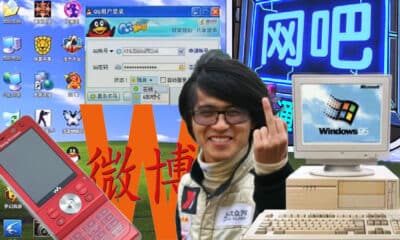

Godfree Roberts
August 23, 2021 at 8:44 am
“During the Great Chinese Famine (1959-1961)”??
There was no Great Chinese Famine between 1959-1961. There were three difficult years, but nobody starved to death.
There was a Great Chinese Famine in 1942, during which millions starved to death, but that’s another matter.
There is a claimed, Great Famine in 1959-61, but the claims lack evidence, motive, or explanation and the book by the principal claimant, Frank Dikotter, is untrustworthy–even on its face. The cover image of a starving Chinese child was taken in 1942 (because, the author explained, “I couldn’t find any pictures of starvation from 1959-60).
There WAS an El Nino event from 1959-60 and there WAS an American embargo on exporting grain to China–designed to starve the country into submission, but even the CIA admitted that it had not failed:
April 4, 1961: The Chinese Communist regime is now facing the most serious economic difficulties it has confronted since it concentrated its power over mainland China. As a result of economic mismanagement, and especially of two years of unfavorable weather, food production in 1960 was hardly larger than in 1957, at which time there were about 50 million fewer Chinese to feed. Widespread famine does not appear to be at hand. Still, in some provinces, many people are now on a bare subsistence diet, and the bitterest suffering lies immediately ahead, in the period before the July harvests. The dislocations caused by the ‘Leap Forward’ and the removal of Soviet technicians have disrupted China’s industrialization program. These difficulties have sharply reduced the rate of economic growth during 1960 and have created a severe balance of payments problem. Public morale, especially in rural areas, is almost certainly at its lowest point since the Communists assumed power, and there have been some instances of open dissidence.
May 2, 1962: The future course of events in Communist China will be shaped largely by three highly unpredictable variables: the wisdom and realism of the leadership, the level of agricultural output, and the nature and extent of foreign economic relations. During the past few years, all three variables have worked against China. In 1958, the leadership adopted a series of ill-conceived and extremist economic and social programs; in 1959, there occurred the first of three years of bad crop weather; and in 1960, Soviet economic and technical cooperation was largely suspended. The combination of these three factors has brought economic chaos to the country. Malnutrition is widespread, foreign trade is down, and industrial production and development have dropped sharply. No quick recovery from the regime’s economic troubles is in sight.
Ridiculing the Great Leap Forward as ‘The Great Leap Backward,’ Edgar Snow confirmed the CIA’s findings:
Were the 1960 calamities as severe as reported in Peking, ‘the worst series of disasters since the nineteenth century,’ as Chou En-lai told me? The weather was not the only cause of the disappointing harvest, but it was undoubtedly a major cause. With good weather, the crops would have been ample; without it, other adverse factors I have cited–some discontent in the communes, bureaucracy, transportation bottlenecks–weighed heavily. Merely from personal observations in 1960, I know that there was no rain in large areas of northern China for 200-300 days. I have mentioned unprecedented floods in central Manchuria where I was marooned in Shenyang for a week …while eleven typhoons struck northeast China–the largest number in fifty years, and I saw the Yellow River reduced to a small stream. Throughout 1959-1962, many Western press editorials continued referring to ‘mass starvation’ in China and continued citing no supporting facts. As far as I know, no report by any non-Communist visitor to China provides an authentic instance of starvation during this period. Here I am not speaking of food shortages, or lack of surfeit, to which I have made frequent reference, but of people dying of hunger, which is what ‘famine’ connotes to most of us, and what I saw in the past.
Felix Greene, too, traveled throughout China in 1960:
With the establishment of the new Government in Peking in 1949, two things happened. First, starvation–death by hunger–ceased in China. There have been food shortages–and severe ones, but no starvation–a fact fully documented by Western observers. The truth is that the sufferings of the ordinary Chinese peasant from war, disorder, and famine have been immeasurably less in the last decade than in any other decade in the century.
Sky
March 13, 2024 at 6:53 pm
It is Zhang Li Na not Zhang Nali.
Manya
March 25, 2024 at 1:17 pm
Adjusted, thanks!